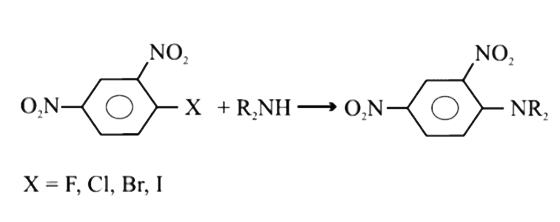In a substitution reaction of the type
Which one of the following has the highest relative rate?
The correct Answer is:B
To determine which compound has the highest relative rate in an SN2 substitution reaction of the type R−Br+Cl−DMF→R−Cl+Br−, we need to analyze the structure of the alkyl halides involved. The rate of an SN2 reaction is influenced by steric hindrance around the carbon atom that is being attacked by the nucleophile (in this case, Cl−).
1. Understanding SN2 Mechanism:
- In an SN2 reaction, the nucleophile attacks the carbon atom from the opposite side of the leaving group (Br in this case). This backside attack is essential for the reaction to occur.
2. Steric Hindrance Consideration:
- The rate of an SN2 reaction decreases with increasing steric hindrance. Therefore, primary (1°) alkyl halides react faster than secondary (2°), and tertiary (3°) alkyl halides are generally not reactive in SN2 reactions due to significant steric hindrance.
3. Analyzing the Given Options:
- We need to evaluate the four options provided to identify which one is a primary alkyl halide or has the least steric hindrance.
- Option A: A tertiary alkyl halide (3°) will have the highest steric hindrance.
- Option B: A primary alkyl halide (1-bromoethane) with minimal steric hindrance.
- Option C: A secondary alkyl halide (2°), which has more steric hindrance than a primary.
- Option D: A tertiary alkyl halide (3°) with significant steric hindrance.
4. Identifying the Fastest Reaction:
- Since primary alkyl halides experience the least steric hindrance, they will have the highest rate of reaction in an SN2 mechanism.
- Among the options, Option B (1-bromoethane) is the primary alkyl halide and will thus have the highest relative rate of reaction.
Conclusion:
The compound with the highest relative rate in the SN2 reaction is Option B (1-bromoethane).
---
- In an SN2 reaction, the nucleophile attacks the carbon atom from the opposite side of the leaving group (Br in this case). This backside attack is essential for the reaction to occur.
- The rate of an SN2 reaction decreases with increasing steric hindrance. Therefore, primary (1°) alkyl halides react faster than secondary (2°), and tertiary (3°) alkyl halides are generally not reactive in SN2 reactions due to significant steric hindrance.
- We need to evaluate the four options provided to identify which one is a primary alkyl halide or has the least steric hindrance.
- Option A: A tertiary alkyl halide (3°) will have the highest steric hindrance.
- Option B: A primary alkyl halide (1-bromoethane) with minimal steric hindrance.
- Option C: A secondary alkyl halide (2°), which has more steric hindrance than a primary.
- Option D: A tertiary alkyl halide (3°) with significant steric hindrance.
- Since primary alkyl halides experience the least steric hindrance, they will have the highest rate of reaction in an SN2 mechanism.
- Among the options, Option B (1-bromoethane) is the primary alkyl halide and will thus have the highest relative rate of reaction.
The compound with the highest relative rate in the SN2 reaction is Option B (1-bromoethane).
Similar Questions
Knowledge Check
- Question 1 - Select One
Which one of the following is most electronegative? F Cl Br I
AFBClCBrDI - Question 2 - Select One
Which one of the following is least reactive element? F Cl Br I
AFBClCBrDI - Question 3 - Select One
Consider the given reaction, RCOOAgBr2/Δ−−−−−−→CCl4R−Br
Which one of the following acids will give maximum yield of R-Br in the above reaction?A B
B C
C DAll will give same yield
DAll will give same yield
Consider the given reaction,RCOOAgBr2/Δ−−−−→CCl4R−Br
Which one of the following acids will give maximum yield of R-Br in the above reaction ?View SolutionSelect odd one from the following and justify your answer.
F, Cl, Br, OView SolutionR−CH2−CCl2−RReagent−−−−→R−C≡C−R
The reagent used isView SolutionPropene on reaction with Br2inCCl4 yields
View SolutionC3H9ClA↓Br2,CCl4Negative testalc.KOH−−−−−→B(C5H8)No isomers↓Br2,CCl4Positive testO3−−−−−→(CH3)2SC5H6O2 which of the following is the structure of A?
View Solution


